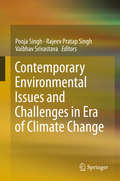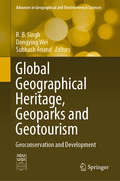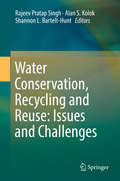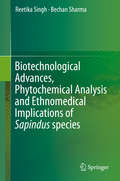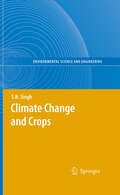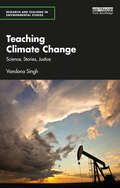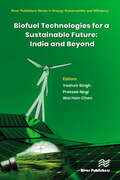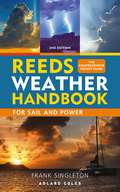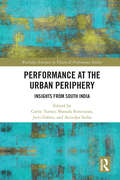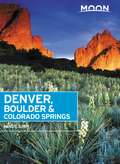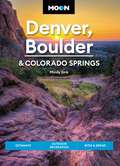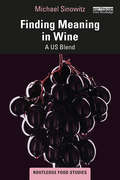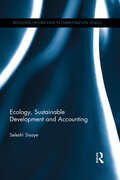- Table View
- List View
Contemporary Environmental Issues and Challenges in Era of Climate Change
by Pooja Singh Rajeev Pratap Singh Vaibhav SrivastavaOver the last few decades, unprecedented global population growth has led to increased demand for food and shelter. At the same time, extraction of natural resources beyond the Earth’s resilience capacity has had a devastating effect on ecosystems and environmental health. Furthermore, climate change is having a significant impact in a number of areas, including the global hydrological cycle, ecosystem functioning, coastal vulnerability, forest ecology, food security, and agricultural sustainability. According to the Intergovernmental Panel on Climate Change (IPCC), only immediate and sustained action will prevent climate change causing irreversible and potentially catastrophic damage to our environment. This book presents various scientific views and concepts, research, reviews, and case studies on contemporary environmental issues in changing climate scenarios and highlights different adaptation measures. Increasing awareness of modern-day patterns of climate change, it addresses questions often raised by environmental scientists, researchers, policymakers and general readers.
Urban Development Challenges, Risks and Resilience in Asian Mega Cities (Advances in Geographical and Environmental Sciences)
by R. B. SinghIn this book, an interdisciplinary research group of faculty members, researchers, professionals, and planners contributed to an understanding of the dynamics and dimensions of emerging challenges and risks in megacities in the rapidly changing urban environments in Asia and examined emerging resilience themes from the point of view of sustainability and public policy. The world’s urban population in 2009 was approximately 3.4 billion and Asia’s urban population was about 1.72 billion. Between 2010 and 2020, 411 million people will be added to Asian cities (60 % of the growth in the world’s urban population). By 2020, of the world’s urban population of 4.2 billion, approximately 2.2 billion will be in Asia. China and India will contribute 31.3 % of the total world urban population by 2025. Developing Asia’s projected global share of CO2 emissions for energy consumption will increase from 30 % in 2006 to 43 % by 2030. City regions serve as magnets for people, enterprise, and culture, but with urbanisation , the worst form of visible poverty becomes prominent. The Asian region, with a slum population of an estimated 505.5 million people, remains host to over half of the world’s slum population . The book provides information on a comprehensive range of environmental threats faced by the inhabitants of megacities. It also offers a wide and multidisciplinary group of case studies from rapidly growing megacities (with populations of more than 5 million) from developed and developing countries of Asia.
Mountain Landscapes in Transition: Effects of Land Use and Climate Change (Sustainable Development Goals Series)
by R. B. Singh Udo Schickhoff Suraj MalThis book compiles available knowledge of the response of mountain ecosystems to recent climate and land use change and intends to bridge the gap between science, policy and the community concerned. The chapters present key concepts, major drivers and key processes of mountain response, providing transdisciplinary orientation to mountain studies incorporating experiences of academics, community leaders and policy-makers from developed and less developed countries. The book chapters are arranged in two sections. The first section concerns the response processes of mountain environments to climate change. This section addresses climate change itself (past, current and future changes of temperature and precipitation) and its impacts on the cryosphere, hydrosphere, biosphere, and human-environment systems. The second section focuses on the response processes of mountain environments to land use/land cover change. The case studies address effects of changing agriculture and pastoralism, forest/water resources management and urbanization processes, landscape management, and biodiversity conservation. The book is designed as an interdisciplinary publication which critically evaluates developments in mountains of the world with contributions from both social and natural sciences.
Urban Health Risk and Resilience in Asian Cities (Advances in Geographical and Environmental Sciences)
by R. B. Singh Bathula Srinagesh Subhash AnandThis book focuses on understanding urban vulnerability and risk mitigation, advancing good health and wellbeing, and analysing resilience measures for various Asian cities. Today, cities are the dominant human habitat, where a large number of environmental, social, cultural and economic factors have impacts on human health and wellbeing. Cities consist of complex, dynamic, socio-ecological, and technological systems that serve multiple functions in human health and wellbeing. Currently half of Asia’s population is urban, and that figure is expected to rise to 66 percent by 2050. Since urban areas are often most vulnerable to hazards, the people living in them need good health infrastructure facilities and technological support at various scales. As such, the need of the hour is to enhance the adaptive capacity, strengthen resilience, reduce vulnerability, and take risk mitigation measures in urban areas, which requires a systematic approach based on science–policy interface that is transformative, trans-disciplinary and integrative for a sustainable urban future. Global sustainable development goals are closely tied to urban human health and wellbeing: (1) the third of the United Nations’ Sustainable Development Goals is to “Ensure healthy lives and promote wellbeing for all at all ages” and (2) the eleventh is to “Make cities inclusive, safe, resilient and sustainable”. By addressing these goals, this book offers a highly useful resource for anyone concerned with healthy and resilient cities in Asia, today and tomorrow.
Global Geographical Heritage, Geoparks and Geotourism: Geoconservation and Development (Advances in Geographical and Environmental Sciences)
by R. B. Singh Dongying Wei Subhash AnandThis book explores the geographical, geomorphological, ecological, touristic and socioeconomic aspects of natural heritage, argues for the dynamic conservation of that heritage and explains its key characteristics, promotion, conservation and management to achieve sustainable development goals. Emerging concepts such as geodiversity, geographical heritage sites, geomonuments, geoparks and geotourism are increasingly being used by conservationists. At present, the development of geoparks is a major global theme involving the application of geosciences to promote the inclusive growth of society and the protection and conservation of our unique geoheritage. Currently, there are 147 UNESCO global geoparks across 41 countries, in addition to a number of national-level geoparks. Pursuing a holistic approach towards such sites will sensitise the general public to the need for geoconservation of significant geosites and promote it through geotourism. It is a crucial issue, as various countries around the world are eager to develop their geoparks and are working for the conservation of geoheritage sites at the national level. This unique book gathers contributions from 15 countries in the form of case studies analysing the realities on of geographical heritage, geoparks and geotourism. The respective chapters address the role of geoparks as essential tools for education, recreation and nature conservation. Given its scope, the book offers a valuable guide for geoscientists, planners, policymakers, civil society and anyone concerned about the conservation of geoheritage sites and geoparks for a sustainable future Earth.
Water Conservation, Recycling and Reuse: Issues and Challenges
by Rajeev Pratap Singh Alan S. Kolok Shannon L. Bartelt-HuntWater - a basic element of life, livelihood, food security and sustainable development - holds the key to global sustainability. The global water demand has been increased 3-fold in the past five decades and only 0.4% of the total world’s fresh water resources is available and accessible for use. The United Nations projected that half of all countries will face water scarcity by 2025 and more than one-third of the world’s population could be affected by water stress by 2050. The water problem is rapidly intensifying in the Asian region, and around 700 million people do not have access to safe drinking water. Similarly, according to the Intergovernmental Panel on Climate Change (IPCC) report, by 2050, more than one billion people in Asia alone are projected to experience negative impacts on water resources as a result of climate change. Climate change is also putting extra pressure on and adversely affecting the global water cycle, leading to irregular precipitation, more floods and droughts and creating an imbalance between water supply and demand. The availability of safe water is a major global concern due to the rapidly increasing population, urbanization, unsustainable consumption patterns, and rapid shifts in land use. It is believed that reduced access to freshwater will have cascading consequences that will pose threat to global food security, livelihood security, and cause large scale migration and economic and geopolitical tensions. As such, strategies for water conservation, wastewater reuse and recycling should be adopted in order to lessen the gap between supply and demand for water for different activities. This book provides readers with a better understanding of the water security challenges, and presents innovations to address these challenges, strengthen the science-policy interface, and develop institutional and human capacities for water security and sustainability.
Climate Change, Glacier Response, and Vegetation Dynamics in the Himalaya: Contributions Toward Future Earth Initiatives
by Rb Singh Udo Schickhoff Suraj MalThis book provides information essential for anyone interested in climate and environmental change of the Himalayan region, including land and resource managers, environmental planners, conservationists, environmentalists, geographers, climatologists, ecologists, and students. The book is unique in its coverage of the current understanding of the science of climate change in the Himalayan mountain system and of the major impacts on physical systems and ecosystems. The book gives an overview of the physical science basis of climate change and explains drivers and processes of glacier and vegetation dynamics. The book covers relevant aspects of accelerated climate change observed in the Himalayan mountain system, and highlights the regional differentiation of climatic changes and associated environmental modifications. The focus is on climate variability and change, and how physical systems and ecosystems respond to climate change impacts. Consequences include impacts on physical systems such as glacier shrinkage, glacial lake outburst floods, altered hydrological characteristics, permafrost warming and thawing, and mass movements on slopes. Climate change is also a powerful stressor on ecosystems and induces range shifts of plant and animal species and alterations in terms of phenology, biomass, plant cover, plant group dominance and species composition. Thus, ecosystem structure and functioning will be strongly affected. The book has an introductory chapter followed by a section on climate change, a section on impacts on glaciers and hydrology, and a section on vegetation dynamics. Each section has several chapters presenting key concepts, major drivers and key processes of environmental change in the Himalayan region from different perspectives. Climate change impacts in the Himalaya have not been studied in much detail, and respective findings were not presented so far in a comprehensive overview. This book summarizes the current knowledge of interactions between climate change and the dynamics of glaciers, hydrology, and vegetation.
Biotechnological Advances, Phytochemical Analysis and Ethnomedical Implications of Sapindus species
by Reetika Singh Bechan SharmaPlants have always occupied a prominent position in the life of every living being. Plants are the primary source of food, shelter and medicines. The global inclination toward herbal medicine has advanced the expansion of plant-based pharmaceutical industries to a vast extent. The production of traditional medicine at global market has been estimated to touch US $5 trillion by 2050. Some of the useful plant-based drugs include vinblastine, vincristine, taxol, podophyllotoxin, camptothecin, digoxigenin, morphine, codeine, aspirin, atropine, capscicine, allicin, curcumin, artemesinin and ephedrine. Genus Sapindus is an important economical and medicinal trees, distributed over the world. Soap nuts contain higher amount of saponin, a natural detergent which can be used to clean clothes and hairs. Sapindus species possesses various pharmacological properties including antimicrobial, antioxidant, anti-inflammatory, anticancer, hepatoprotective, anti-trichomonas activity. Extracts of this plant are rich in various phytochemicals and polyphenolic compounds. All the pharmacological properties are due to presence of saponins. Biotechnological techniques can improve the saponin content; thus this chemical content can be produced at large scale and can be used as phytomedicine. We hope that this book would be of great use to under graduates, postgraduates, scientists, researchers and faculty members who are studying, teaching or working in the field of Biotechnology, Phytochemistry and Ethnopharmacology. The techniques explained in this book could be of immense use for the researchers working in this area. We shall deeply appreciate receiving any critical comments and suggestions from the readers from the different parts of globe which would help us improve the first edition of this publication.
Climate Change and Crops (Environmental Science and Engineering)
by S. N. SinghClimate change is directly linked to the human activities, according to the Fourth Assessment Report of IPCC (2007). In last two decades of 20th Century, accelerated anthropogenic activities pushed up the atmospheric abundance of greenhouse gases, mainly CO2, CH4, and N2O, alarmingly which enhanced the radiative forcing of the Earth’s surface and thus perturbed its heat radiation balance. As a consequence, atmospheric characteristics, such as temperature, rainfall pattern, levels of CO2 and O3 have changed significantly, affecting the farm productivity. Although rising level of CO2 may have fertilizing effect on C3 crops, but concomitant rise in atmospheric temperature, O3 level and extreme weather conditions can not only nullify the fertilizing effect of CO2, but also drastically reduce the crop production, threatening food security to burgeoning world population. Agricultural crops are not only victim of climate variability and extreme whether conditions, but also serve as a potential source of CH4 and N2O. Therefore, in changed scenario, Kyoto Protocol (1997) has sought all signatory developed nations to cut down their emission levels as per their differential commitments to UNFCCC and developing nations to invest in less carbon emission projects to avert the process of global warming process. In this context, the present edition, which compiles latest findings of studies carried out by the scientists on climate change and crops around the world, serves as a ready reckoner to crop scientists, atmospheric scientists, ecologists, environmentalists, research scholars and post- graduate students to update their knowledge and understanding on this issue.
Environmental Bioremediation Technologies
by S. N. Singh R. D. TripathiBioremediation is an eco-friendly, cost-effective and natural technology targeted to remove heavy metals, radionuclides, xenobiotic compounds, organic waste, pesticides etc. from contaminated sites or industrial discharges through biological means. Since this technology is used in in-situ conditions, it does not physically disturb the site unlike conventional methods i.e. chemical or mechanical methods.
Geographic Information Science for Land Resource Management
by Suraj Kumar Singh Shruti Kanga Gowar Meraj Majid Farooq Sudhanshu SudhanshuGeographic Information Science for Land Resource Management is a comprehensive book focusing on managing land resources using innovative techniques of spatial information sciences and satellite remote sensing. The enormous stress on the land resources over the years due to anthropogenic activities for commercialization and livelihood needs has increased manifold. The only solution to this problem lies in the stakeholders' awareness, which can only be attained through scientific means. The awareness is the basis of the sustainable development concept, which involves optimal management of natural resources, subject to the availability of reliable, accurate, and timely information from the global to local scales. GIScience consists of satellite remote sensing (RS), Geographical Information System (GIS), and Global Positioning System (GPS) technology that is nowadays a backbone of environmental protection, natural resource management, and sustainable development and planning. Being a powerful and proficient tool for mapping, monitoring, modeling, and managing natural resources can help understand the earth's surface and its dynamics at different observational scales. Through the spatial understanding of land resources, policymakers can make prudent decisions to restore and conserve critically endangered resources, such as water bodies, lakes, rivers, air, forests, wildlife, biodiversity, etc. This innovative new volume contains chapters from eminent researchers and experts. The primary focus of this book is to replenish the gap in the available literature on the subject by bringing the concepts, theories, and experiences of the specialists and professionals in this field jointly. The editors have worked hard to get the best literature in this field in a book form to help the students, researchers, and policymakers develop a complete understanding of the land system's vulnerabilities and solutions.
Geographic Information Science for Land Resource Management
by Suraj Kumar Singh Shruti Kanga Gowhar Meraj Majid Farooq SudhanshuGeographic Information Science for Land Resource Management is a comprehensive book focusing on managing land resources using innovative techniques of spatial information sciences and satellite remote sensing. The enormous stress on the land resources over the years due to anthropogenic activities for commercialization and livelihood needs has increased manifold. The only solution to this problem lies in the stakeholders' awareness, which can only be attained through scientific means. The awareness is the basis of the sustainable development concept, which involves optimal management of natural resources, subject to the availability of reliable, accurate, and timely information from the global to local scales. GIScience consists of satellite remote sensing (RS), Geographical Information System (GIS), and Global Positioning System (GPS) technology that is nowadays a backbone of environmental protection, natural resource management, and sustainable development and planning. Being a powerful and proficient tool for mapping, monitoring, modeling, and managing natural resources can help understand the earth's surface and its dynamics at different observational scales. Through the spatial understanding of land resources, policymakers can make prudent decisions to restore and conserve critically endangered resources, such as water bodies, lakes, rivers, air, forests, wildlife, biodiversity, etc. This innovative new volume contains chapters from eminent researchers and experts. The primary focus of this book is to replenish the gap in the available literature on the subject by bringing the concepts, theories, and experiences of the specialists and professionals in this field jointly. The editors have worked hard to get the best literature in this field in a book form to help the students, researchers, and policymakers develop a complete understanding of the land system's vulnerabilities and solutions.
Teaching Climate Change: Science, Stories, Justice (Research and Teaching in Environmental Studies)
by Vandana SinghTeaching Climate Change: Science, Stories, Justice shows educators how climate change can be taught from any disciplinary perspective and in a transdisciplinary way, drawing on examples from the author's own classroom. The book sets out a radical vision for climate pedagogy, introducing an innovative framework in which the scientific essentials of climate change are scaffolded via three transdisciplinary meta-concepts: Balance/Imbalance, Critical Thresholds and Complex Interconnections. Author Vandana Singh grounds this theory in practice, drawing on examples from her own classroom to provide implementable ideas for educators, and to demonstrate how climate change can be taught from any disciplinary perspective in a transdisciplinary way. The book also explores the barriers to effective climate education at a macro level, focusing on issues such as climate misinformation/misconception, the exclusion of social and ethical concerns and a focus on technofixes. Singh uses this information to identify four key dimensions for an effective climate pedagogy, in which issues of justice are central: scientific-technological, the transdisciplinary, the epistemological and the psychosocial. This approach is broad and flexible enough to be adapted to different classrooms and contexts. Bridging the social and natural sciences, this book will be an essential resource for all climate change educators practicing in both formal and informal settings, as well as for community climate activists.
Teaching Climate Change: Science, Stories, Justice (Research and Teaching in Environmental Studies)
by Vandana SinghTeaching Climate Change: Science, Stories, Justice shows educators how climate change can be taught from any disciplinary perspective and in a transdisciplinary way, drawing on examples from the author's own classroom. The book sets out a radical vision for climate pedagogy, introducing an innovative framework in which the scientific essentials of climate change are scaffolded via three transdisciplinary meta-concepts: Balance/Imbalance, Critical Thresholds and Complex Interconnections. Author Vandana Singh grounds this theory in practice, drawing on examples from her own classroom to provide implementable ideas for educators, and to demonstrate how climate change can be taught from any disciplinary perspective in a transdisciplinary way. The book also explores the barriers to effective climate education at a macro level, focusing on issues such as climate misinformation/misconception, the exclusion of social and ethical concerns and a focus on technofixes. Singh uses this information to identify four key dimensions for an effective climate pedagogy, in which issues of justice are central: scientific-technological, the transdisciplinary, the epistemological and the psychosocial. This approach is broad and flexible enough to be adapted to different classrooms and contexts. Bridging the social and natural sciences, this book will be an essential resource for all climate change educators practicing in both formal and informal settings, as well as for community climate activists.
Climate Change Impacts: Select Proceedings of ICWEES-2016 (Water Science and Technology Library #82)
by Vijay P Singh Shalini Yadav Ram Narayan YadavaThis book comprises the select proceedings of the International Conference on Water, Environment, Energy and Society. The book is divided into four parts. Part I deals with some aspects of climatic characteristics ranging from changes in temperature and sunshine hours to downscaling to global climate patterns and effects of El Niño-Southern Oscillation (ENSO) and Indian Ocean Dipole (IOD) on extreme rainfall. Part II covers rainfall analysis, including changes in regional rainfall series, analysis of non-stationarity, summer monsoon and rainfall scenarios. Impacts of climate change are treated in Part III. Change point analysis, greenhouse gas emissions, rainfall variability, water resources variability, and water resources sustainability are discussed in this part. The concluding Part IV is on low flow and drought. It deals with the Standardized Precipitation Index (SPI) concept and assessment of drought. This book is of interest to researchers and practitioners in the field of water resources, hydrology, environmental resources, agricultural engineering, watershed management, and earth sciences, as well as those engaged in natural resources planning and management. Graduate students and those wishing to conduct further research in water and environment and their development and management find the book to be of value.
Biofuel Technologies for a Sustainable Future: India and Beyond
by Yashvir Singh Prateek Negi Wei Hsin ChenThis book examines the key aspects that will define future sustainable energy systems: biofuels, green nanomaterials and the production of bioethanol and bio-hydrogen from bio-waste. Bio-based fuels are the future energy carriers for internal combustion engines as they have lower environmental impact and higher efficiency. The book clearly illustrates the requirement for a unified engineering approach based on solid mathematical and engineering principles. Aside from the ecological advantages, support for sustainable energy can help the socioeconomic situation of developing countries by providing a consistent supply of new energy along with the generation of new job opportunities. The sustainable energy applications and existing contextual investigations provide useful guidance for the broad comprehension of the significance of sustainable energy. Technical topics discussed in the book include: Thermochemical Conversion process; Catalytic conversion process; Rankine cycle; Nanomaterials;
Reeds Weather Handbook: For Sail And Power
by Frank SingletonWeather determines when we sail, where we sail to – and whether we arrive safely. This essential pocket-sized guide equips the reader with all the necessary tools to predict and deal with local and distant weather conditions, whether on a day trip or a longer cruise, along the coast or further offshore.Each topic is broken down into digestible chapters, explaining the origins and effects of the full spectrum of weather conditions, including:- using and evaluating weather forecasts- depressions, fronts, isobars and other coastal effects- waves and swell- weather lore and sky watching. Meteorology is still advancing and sources of forecasts are changing. This new edition keeps the handbook up-to-date, with a particular focus on the increasing use of GRIB files, computer weather modelling and sources of forecasts, especially with the proliferation of computer forecasts becoming available free of charge.With practical explanations and helpful diagrams and photographs, this is the ideal aide-memoire for skippers and crew, especially those studying for their Day Skipper and Yachtmaster exams.
Reeds Weather Handbook
by Frank SingletonWeather determines when we sail, where we sail to – and whether we arrive safely. This essential pocket-sized guide equips the reader with all the necessary tools to predict and deal with local and distant weather conditions, whether on a day trip or a longer cruise, along the coast or further offshore.Each topic is broken down into digestible chapters, explaining the origins and effects of the full spectrum of weather conditions, including:- using and evaluating weather forecasts- depressions, fronts, isobars and other coastal effects- waves and swell- weather lore and sky watching. Meteorology is still advancing and sources of forecasts are changing. This new edition keeps the handbook up-to-date, with a particular focus on the increasing use of GRIB files, computer weather modelling and sources of forecasts, especially with the proliferation of computer forecasts becoming available free of charge.With practical explanations and helpful diagrams and photographs, this is the ideal aide-memoire for skippers and crew, especially those studying for their Day Skipper and Yachtmaster exams.
Performance at the Urban Periphery: Insights from South India (Routledge Advances in Theatre & Performance Studies)
by Anindya Sinha Cathy Turner Jerri Daboo Sharada SrinivasanThis edited volume considers performance in its engagement with expanding Indian cities, with a particular focus on festivals and performances in Karnataka, Tamil Nadu and Kerala. The editors ask how performance practices are affected by urbanisation, the effects of such changes on their cultural economy, and the environmental impacts of performance itself. This project also considers how performance responds to its context, and the potential for performance to be critical of the city’s development, and of its own compromises. Bringing together perspectives from the humanities, natural and social sciences, the book takes a multi-faceted analytical view of live performance, connecting contemporary with heritage forms, and human with more-than-human actors. The three sections, themed around heritage, everyday life, and future ecologies, will be of great interest to students and scholars in performance, heritage studies, ecology and art history.
Moon Denver, Boulder & Colorado Springs (Travel Guide)
by Mindy SinkWorld-class breweries, rugged mountain peaks, and a funky college town: dive into the diversity of the Front Range with Moon Denver, Boulder & Colorado Springs. Inside you'll find:Flexible itineraries, from a week exploring Denver, Boulder, and Colorado Springs to day trips to nearby ski resorts and Rocky Mountain National ParkStrategic advice for outdoor adventurers, culture and history buffs, foodies, and moreMust-see highlights and unique experiences: Check out a new exhibit at the Denver Art Museum, catch a performance under the open sky at Red Rocks Amphitheatre, or explore the Wild West at the Museum of the American Cowboy. Ski the fresh powder at Loveland or Winter Park and relax with an après-ski drink. Go rafting on the Cache La Poudre river, rock-climb in the Flatirons, or hike slickrock trails to stunning mountain vistas. Savor fresh flavors at a farm-to-table restaurant, try gourmet treats at a buzzing public market, or chat with locals over a delicious microbrewHonest advice from Denver local and lifelong adventurer Mindy Sink on when to go, where to eat, and where to stayFull-color photos and detailed maps throughoutFocused coverage of Denver, Boulder, Colorado Springs, Fort Collins, Golden, and the East Side of Rocky Mountain National ParkThorough background on the culture, weather, wildlife, and historyFind your adventure with Moon Denver, Boulder & Colorado Springs.Exploring beyond the Mile-High City? Try Moon Colorado. Sticking to the park? Pick up Moon Rocky Mountain National Park.
Moon Denver, Boulder & Colorado Springs: Getaways, Outdoor Recreation, Bites & Brews (Travel Guide)
by Mindy SinkWorld-class breweries, rugged mountain peaks, and funky college town vibes: dive into the diversity of the Front Range with Moon Denver, Boulder & Colorado Springs. Inside you'll find:Flexible itineraries, like a week exploring Denver, Boulder, and Colorado Springs and day trips to nearby ski resorts and Rocky Mountain National Park The top outdoor adventures: Go rafting on the Cache La Poudre river, rock-climb in the Flatirons, or hike slickrock trails to stunning mountain vistas. Ski the fresh powder at Loveland or Winter Park and relax with an après-ski drink Must-see highlights and unique experiences: Check out a new exhibit at the Denver Art Museum, catch a performance under the open sky at Red Rocks Amphitheatre, or explore the Wild West at the Museum of the American Cowboy The best local flavors: Indulge in the offerings of a farm-to-table restaurant, try gourmet treats at a buzzing public market, or chat with locals over a delicious microbrew Honest advice from Denver local and lifelong adventurer Mindy Sink on when to go, where to eat, and where to stay Full-color photos and detailed maps throughoutFocused coverage of Denver, Boulder, Colorado Springs, Fort Collins, Golden, and the east side of Rocky Mountain National Park Thorough background on local culture, weather, health and safety, wildlife, and history Find your adventure with Moon Denver, Boulder & Colorado Springs. Exploring beyond the Mile-High City? Try Moon Colorado. Sticking to the park? Pick up Moon Rocky Mountain National Park. About Moon Travel Guides: Moon was founded in 1973 to empower independent, active, and conscious travel. We prioritize local businesses, outdoor recreation, and traveling strategically and sustainably. Moon Travel Guides are written by local, expert authors with great stories to tell—and they can't wait to share their favorite places with you. For more inspiration, follow @moonguides on social media.
Finding Meaning in Wine: A US Blend (Routledge Food Studies)
by Michael SinowitzThis book examines controversies in American wine culture and how those controversies intersect with and illuminate current academic and cultural debates about the environment and about interpretation. With a specific focus on the United States of America, the methods that we use to discuss literature and other art are applied to wine-making and wine culture. The book explores the debates about how to evaluate wine and the problems inherent in numerical scoring as well as evaluative tasting notes, whether winemakers can be artists, the discourse in wine culture involving natural wine and biodynamic farming, as well as how people judge what makes a wine great. These interpretative commitments illuminate an underlying metaphysics and allegiance to a culture of reason or feeling. The discussions engage with a broad range of writers and thinkers, such as Roland Barthes, Susan Sontag, Louis Menand, Michael Pollan, Greg Garrard, John Guillory, Amitov Ghosh, Pierre Bourdieu, and Barbara Herrnstein-Smith. The book draws upon not only a number of texts produced by wine critics, wine writers, literary critics and theorists but also extensive interviews with wine writers and multiple California winemakers. These interviews contribute to a unique reflection on wine and meaning. This book will be of great interest to readers looking to learn more about wine from cultural, literary, and philosophical perspectives.
Finding Meaning in Wine: A US Blend (Routledge Food Studies)
by Michael SinowitzThis book examines controversies in American wine culture and how those controversies intersect with and illuminate current academic and cultural debates about the environment and about interpretation. With a specific focus on the United States of America, the methods that we use to discuss literature and other art are applied to wine-making and wine culture. The book explores the debates about how to evaluate wine and the problems inherent in numerical scoring as well as evaluative tasting notes, whether winemakers can be artists, the discourse in wine culture involving natural wine and biodynamic farming, as well as how people judge what makes a wine great. These interpretative commitments illuminate an underlying metaphysics and allegiance to a culture of reason or feeling. The discussions engage with a broad range of writers and thinkers, such as Roland Barthes, Susan Sontag, Louis Menand, Michael Pollan, Greg Garrard, John Guillory, Amitov Ghosh, Pierre Bourdieu, and Barbara Herrnstein-Smith. The book draws upon not only a number of texts produced by wine critics, wine writers, literary critics and theorists but also extensive interviews with wine writers and multiple California winemakers. These interviews contribute to a unique reflection on wine and meaning. This book will be of great interest to readers looking to learn more about wine from cultural, literary, and philosophical perspectives.
Indigenous Geographies in the Yucatan: Learning From the Responsibility-Based Maya Environmental Ethos (SpringerBriefs in Geography)
by Miguel SiouiThis book is part of a broader attempt to decolonize colonial histories and understandings about Indigenous peoples and their relationships with their territories, and argues that the land ethos of "being part of the land," specifically among the Mayan community of Xuilub (Yucatan), Mexico, is guided by the cultural precept of 'responsibility-based' thinking. The work uniquely adds much needed insights into 'responsibility-based' thinking for land-use practices, and develops a theoretical framework for assessing historical impacts on Indigenous cultures and livelihoods. In six chapters, the text bridges Western and Indigenous Knowledge (IK) approaches to achieve deeper understanding of IKs, focusing on more Indigenous-centered methods, with the goal of expanding the disciplinary perspectives of postcolonial scholarship and Indigenous geographies. The book contains useful information for environmental planning/management scholars and geographers who may not be familiar with Indigenous approaches to land-use, and to Indigenous geographers working to bridge Western and Indigenous methodologies.
Ecology, Sustainable Development and Accounting (Routledge Explorations in Environmental Studies)
by Seleshi SisayeAccounting literature has viewed sustainability in terms of social, economic and environmental performances. There have been concerns that the relationship between sustainability, accounting and organizational performance cannot be explained unless we can deduce patterns of administrative behaviour that chronicle management practices. Ecology, Sustainable Development and Accounting argues that, despite the broader social and economic development dimensions of sustainability and the limitations of its extension to corporate and organizational behaviour; an ecological framework is capable of providing the overall societal and community chronologies that describe corporate sustainable operations. Drawing examples from international development and federal government organizations, this book documents the link between ecology, corporate sustainable development, and sustainability accounting and reporting. It draws together the literature from several disciplines to elaborate the contribution of the ecological approach to sustainable development in the accounting literature. This book will be of particular interest to students, academics and practitioners in the areas of environmental studies, ecological economics, sustainable development studies, and social and environmental accounting. The sociological and anthropological perspectives make this book the first of its kind to apply the population ecology of sociology to both the sustainability and accounting literature.
